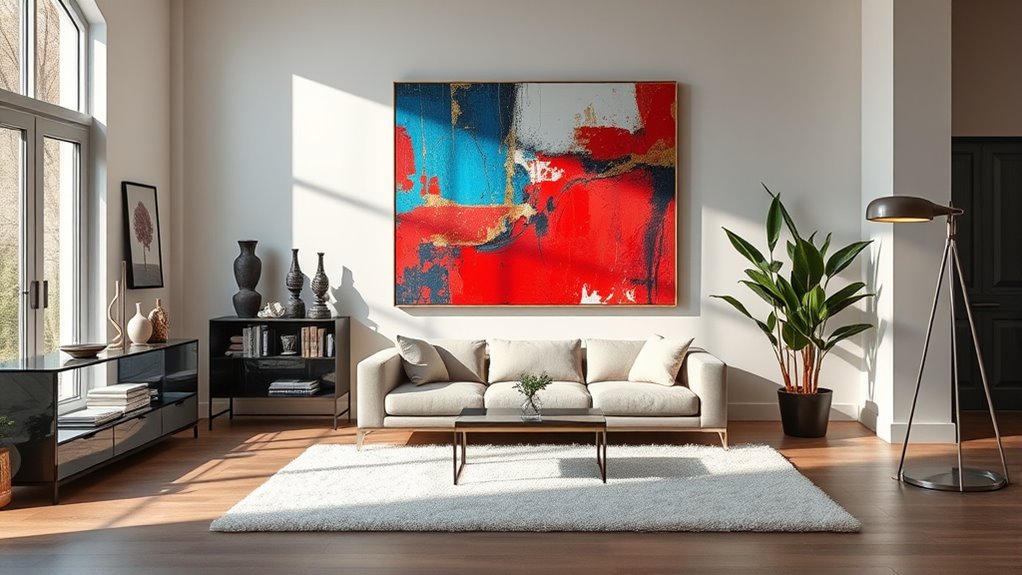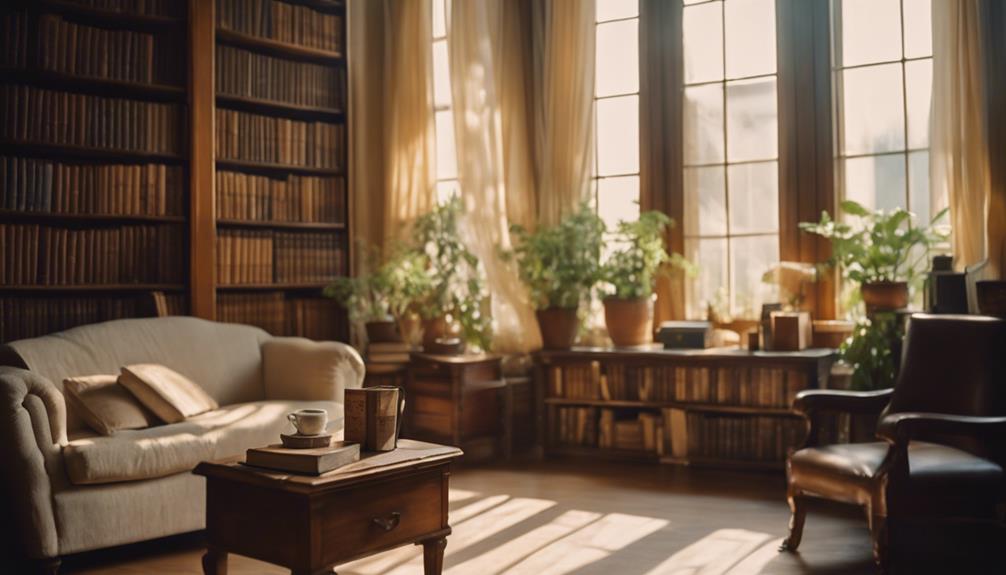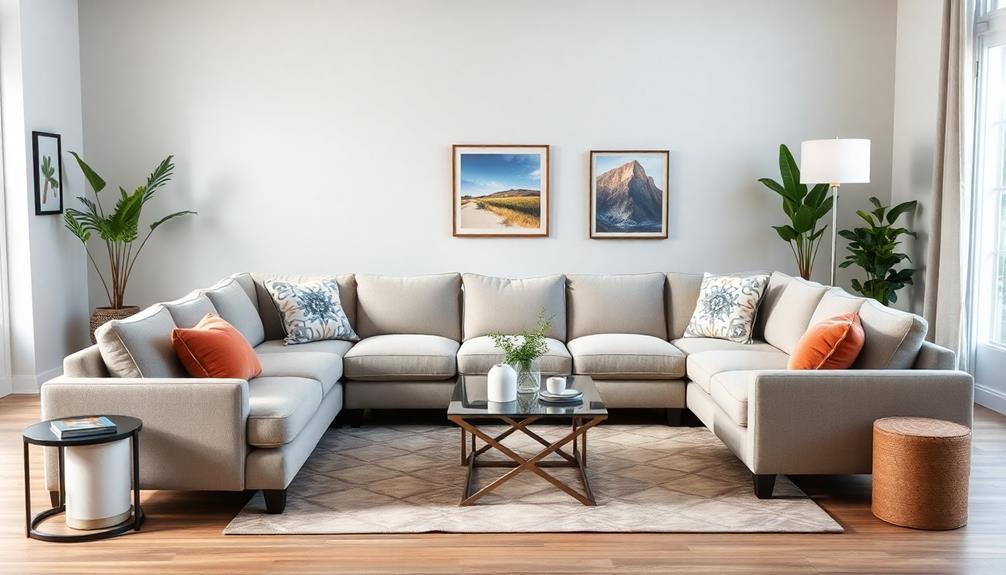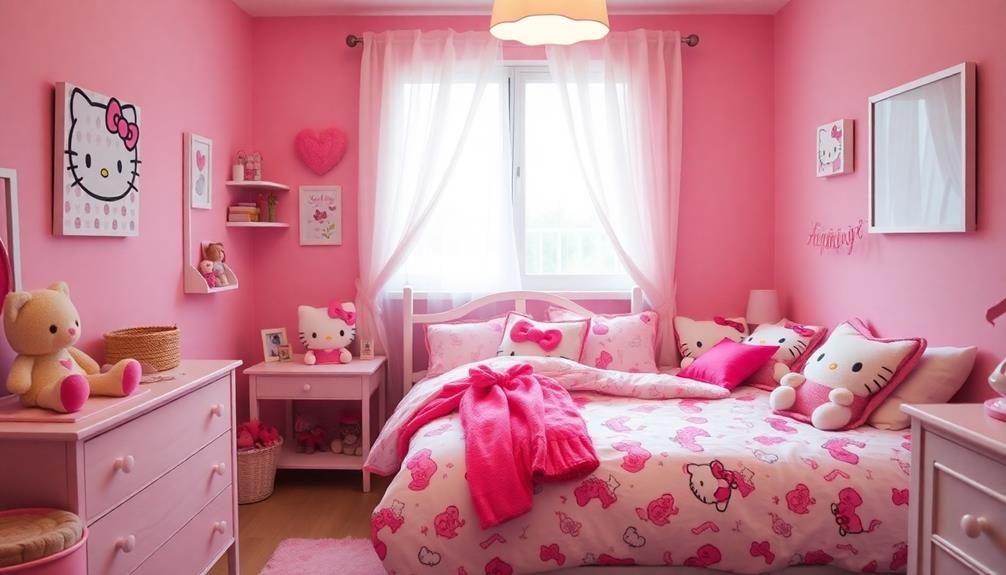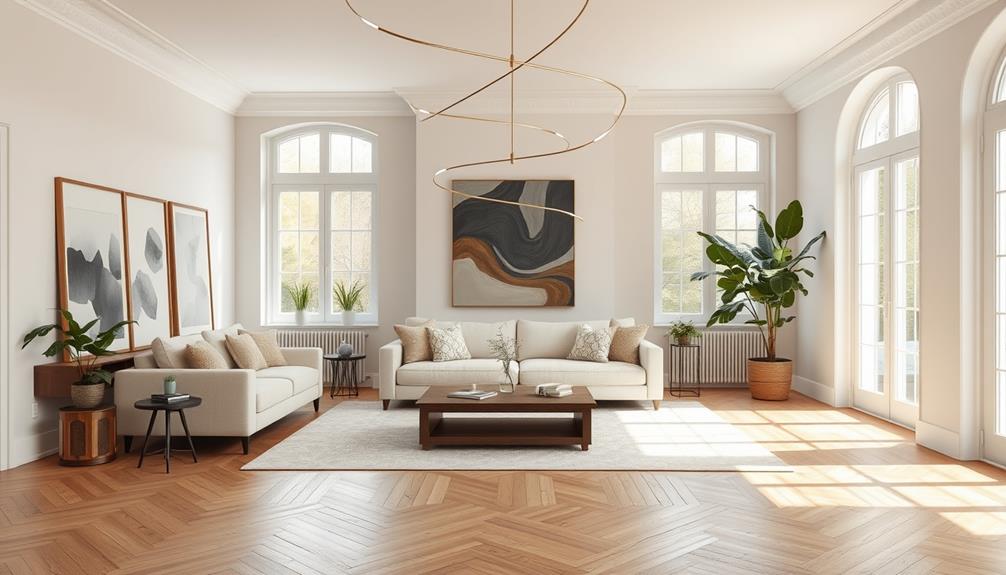To incorporate art into your home, start by understanding your style and space—consider colors, furniture, and lighting. Choose pieces that truly resonate with your interests and emotional response, then think about their size and placement for balance. Create focal points with bold artworks and arrange multiple pieces harmoniously, keeping proportions in check. With proper hanging techniques, you’ll enhance your space effortlessly, and if you keep exploring, you’ll discover even more ways to make your art truly shine.
Key Takeaways
- Assess your personal style and existing décor to select artwork that complements or creates contrast.
- Measure wall space and lighting to determine appropriate artwork size and placement for harmony.
- Choose meaningful pieces that evoke positive emotions and resonate with your interests or cultural background.
- Balance artwork scale with room size and furniture for visual harmony, using grouping and focal points effectively.
- Hang artworks at eye level with proper spacing, hardware, and lighting to enhance aesthetic appeal and room cohesion.
Understanding Your Personal Style and Space
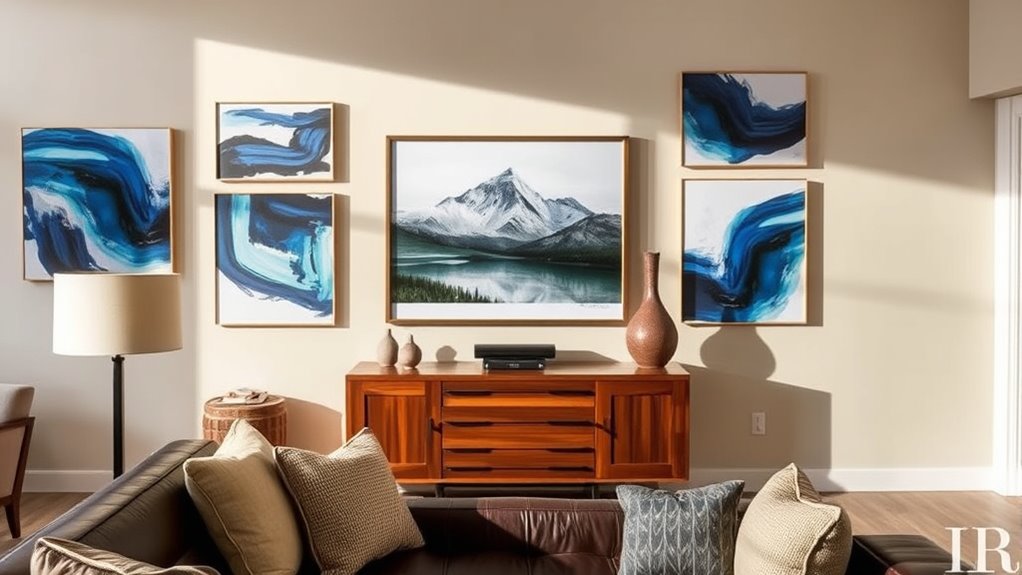
Before selecting art for your home, it’s essential to understand your personal style and the space where you plan to display it. Think about your daily routines and how you want to feel in each area—calm, energized, inspired. Consider your existing décor, colors, and furniture to identify what complements or contrasts effectively. Measure your space accurately, noting wall dimensions and lighting conditions. Visualize how different artworks will fit and influence the room’s atmosphere. Your style might lean toward modern minimalism, eclectic vibrancy, or classic elegance—knowing this guides your choices. By understanding your preferences and the space’s characteristics, you set a foundation for selecting art that truly resonates and enhances your home’s overall design. Additionally, considering color harmony can help ensure that your artwork complements your room’s palette and creates a cohesive look. Recognizing the importance of art placement can further optimize how artworks enhance your living environment. An awareness of lighting conditions is also crucial, as proper lighting can dramatically affect how art appears and impacts the room. Paying attention to rustic elements can help integrate artwork seamlessly into a farmhouse-inspired setting. Incorporating home essentials such as appropriate framing and display accessories can also elevate your art presentation and protect your investment.
Selecting Artwork That Resonates With You
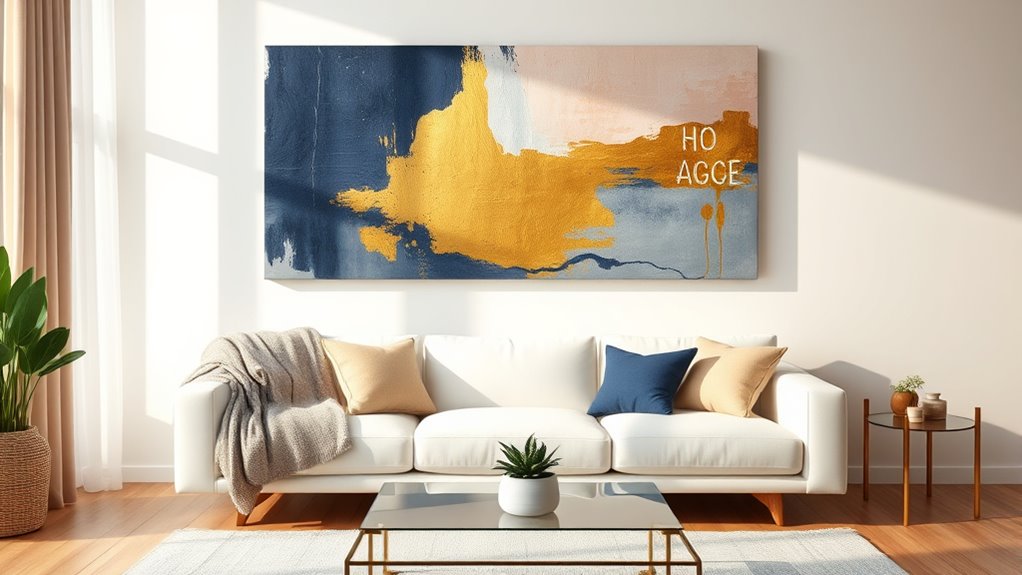
How do you choose artwork that truly speaks to you? Start by reflecting on what evokes an emotional response. Do vibrant colors energize you, or do calming landscapes help you relax? Consider your personal interests and experiences—perhaps a favorite memory or cultural heritage that can be expressed through art. Trust your instincts: if a piece makes you feel something, it’s likely a good fit. Take your time exploring different styles, mediums, and artists. Don’t feel pressured to follow trends; instead, prioritize pieces that resonate on a deeper level. Remember, art is a reflection of your personality and taste. When you select artwork that genuinely connects with you, it will enrich your space and bring joy every time you see it. Be mindful of cookie categories that can help you personalize your browsing experience and discover art that truly reflects your preferences. Additionally, choosing artwork that aligns with your home decor style can create a more harmonious and inviting environment. Incorporating insights from AI in Education, like personalized recommendations, can also assist in finding artwork that perfectly matches your unique style. Understanding artistic styles and movements can further help you identify pieces that resonate with your aesthetic sensibilities. Moreover, exploring the emotional impact of art can guide you toward selections that nurture your well-being and personal growth.
Considering Scale and Proportion in Artwork Placement

When choosing where to hang artwork, consider the wall space and how the piece’s size will fit. Larger pieces work best above substantial furniture, while smaller art suits tight spaces. Keep in mind the room’s function to guarantee the artwork’s scale complements the overall atmosphere. Additionally, understanding costume themes can help in selecting artwork that enhances your decor’s style and narrative. Recognizing beach-inspired aesthetics can add a relaxing, coastal vibe to your interior design, creating a cohesive and inviting space. Incorporating creative practice into your approach can further inspire unique choices and arrangements that reflect your personal style. Being aware of espionage history may also inspire more intriguing and layered display choices that subtly hint at deeper stories. Considering the diverse designs of planters and artwork can also help you create a harmonious and visually engaging environment.
Wall Space Balance
Have you ever noticed how artwork can either enhance or overwhelm a room depending on its size? Achieving wall space balance means considering the proportion of your art relative to the wall and surrounding furniture. Large pieces on small walls can feel cramped, while tiny artworks on expansive walls may seem lost. To create harmony, balance your artwork with the space’s dimensions, ensuring it complements nearby furniture and fixtures. Pay attention to negative space around the art—sometimes, leaving empty space enhances visual appeal better than filling every inch. When placing multiple pieces, group them thoughtfully, maintaining consistent spacing. The importance of proportionality in artwork placement ensures your decor feels cohesive and well-balanced. Additionally, understanding visual balance can help you arrange your art more effectively to achieve harmony in your space. Recognizing the impact of cybersecurity vulnerabilities can also influence how you protect your digital environment, creating a secure and harmonious overall atmosphere. The goal is to make your artwork feel integrated, not overpowering or insignificant, resulting in a cohesive and inviting environment. Incorporating artistic principles, such as contrast and rhythm, can further enhance visual harmony and appeal. Being mindful of psychological research on visual perception can also help you make more informed decisions about placement and style.
Artwork Size Guidelines
Choosing the right size for your artwork is essential to creating a balanced and visually appealing space. Proper sizing ensures your art complements the room’s scale and enhances its overall harmony. To achieve this, keep these guidelines in mind:
- Match artwork width to furniture — aim for artwork that spans approximately 2/3 to 3/4 of the furniture’s width for a cohesive look.
- Consider wall space — for large blank walls, opt for bigger pieces or a gallery wall to fill the space without overwhelming it. Self watering plant pots can serve as a subtle inspiration for balancing elements in your decor.
- Maintain proportion — ensure the height and width of your art relate well to the surrounding elements, avoiding tiny pieces on large walls or oversized art in small rooms. Recognizing visual balance helps in selecting the most harmonious sizes for your space.
- Choose appropriate artwork sizes based on room type — different spaces benefit from specific size ranges to achieve the best visual impact, guided by artwork size guidelines. Additionally, understanding attention to detail can help in selecting pieces that draw the viewer’s eye effectively.
Following these tips will help you select artwork that feels just right and enhances your overall décor.
Room Function Considerations
The function of a room plays a crucial role in determining the appropriate scale and placement of artwork. In a living room, where people gather, choose larger pieces that make a statement without overwhelming the space. For bedrooms, opt for smaller, calming artwork that promotes relaxation. Kitchens and dining areas benefit from artwork that’s lively but not intrusive, often placed above tables or counters. Consider how furniture interacts with your art; a piece should complement or anchor the space. Taller ceilings allow for larger, more dramatic artwork, while lower ceilings call for smaller, thoughtfully scaled pieces. Always think about how your artwork will be viewed; the right size enhances the room’s purpose and creates a balanced, inviting environment. Incorporating textiles and accessories that match your decor style can further harmonize the space and enhance its overall aesthetic. Additionally, understanding the zodiac signs and compatibility can inspire themes or motifs that reflect your personality and relationships, adding a personalized touch to your decor. Recognizing the alimony laws in your area can also influence how you approach decorating, especially if you’re in the process of transitioning to a new phase of life. Being aware of AI security considerations can help you protect your digital assets and personal information as you design your space and online presence.
Creating a Focal Point With Statement Pieces
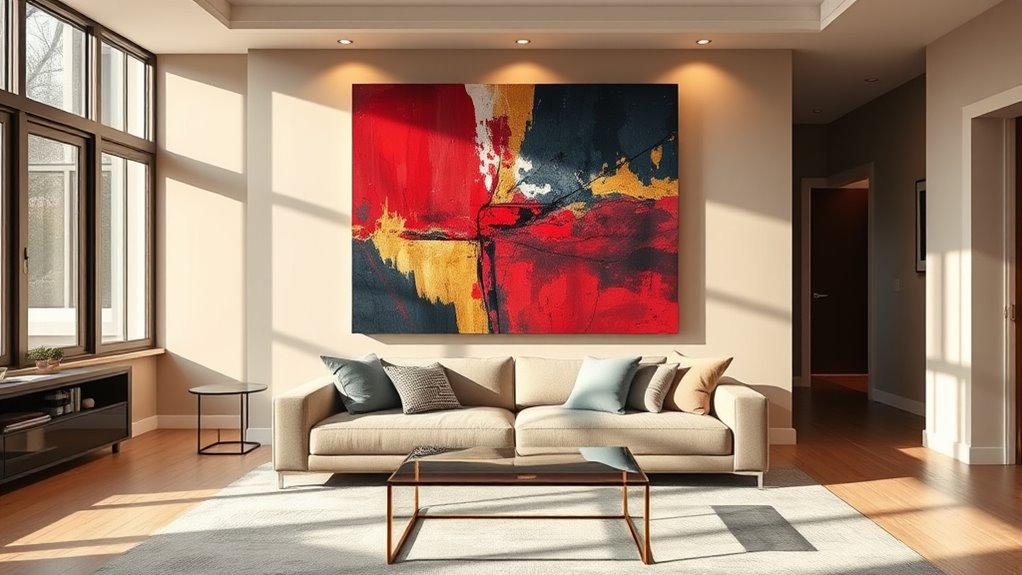
Want to make a striking impression in your living space? Creating a focal point with statement pieces draws attention and sets the tone for your room. First, choose a bold artwork or sculpture that reflects your personality and complements your decor. Second, position it where it naturally catches the eye, like above a fireplace or on a main wall. Third, keep surrounding decor simple to let the statement piece stand out. This approach guarantees your artwork becomes the room’s centerpiece and sparks conversation. Remember, the goal is to create a visual anchor that guides the eye and enhances your space’s overall style. With the right statement piece, your home will instantly feel more curated and inviting.
Tips for Arranging Multiple Pieces Harmoniously
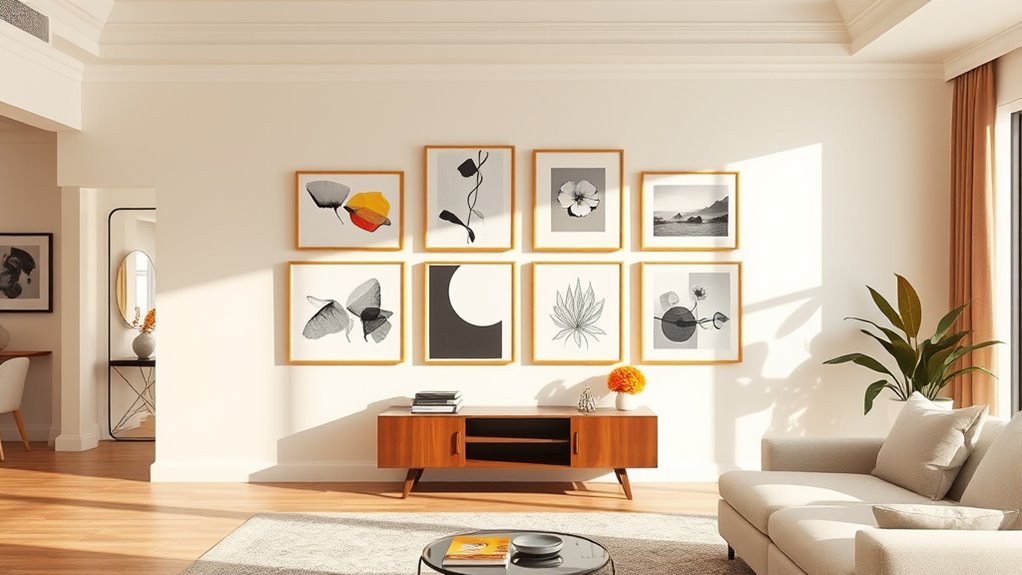
To create a cohesive look, focus on achieving balance and symmetry in your arrangement. Mix different sizes and styles to add interest, but keep spacing consistent to avoid clutter. These tips help your art pieces work together harmoniously without overwhelming the space.
Balance and Symmetry
Achieving balance and symmetry in your home art arrangements creates a harmonious and inviting space. To do this effectively, keep these tips in mind:
- Align pieces at the same height for a clean, orderly look that feels cohesive.
- Use pairs or groups of three for visual stability and rhythm.
- Mirror elements across a central axis to create symmetry without being overly matching.
Focus on distributing visual weight evenly, so no one area feels heavier than another. Incorporate frames, colors, or shapes that complement each other to enhance harmony. Remember, symmetry doesn’t mean everything must be identical—subtle variations can add interest while maintaining a balanced aesthetic. By applying these principles, your artwork will look thoughtfully arranged and inviting.
Varying Sizes and Styles
Varying the sizes and styles of your artwork adds visual interest and prevents your display from feeling monotonous. Mix large statement pieces with smaller, more subtle works to create a dynamic gallery. Incorporate different styles—such as abstract, photography, and traditional paintings—to add texture and personality. When arranging, consider grouping similar themes or colors to maintain cohesion. Play with overlapping or layering pieces for depth, but avoid clutter. Balance is key: place larger pieces where they anchor the display, and fill gaps with smaller works. Don’t be afraid to experiment with different orientations or frames. By mixing sizes and styles thoughtfully, you’ll craft a lively, engaging art arrangement that reflects your personality and enhances your space.
Consistent Spacing
When arranging multiple art pieces, maintaining consistent spacing creates a harmonious and polished look. It helps your display feel intentional and balanced, making each piece stand out without overwhelming the space. To achieve this, consider the following tips:
- Measure and mark the spacing beforehand to ensure uniform gaps between frames.
- Use a level or a template to keep artwork aligned both vertically and horizontally.
- Pay attention to the distance between pieces and the edges of the wall, aiming for equal spaces for a cohesive appearance.
Practical Guidelines for Hanging and Positioning Art
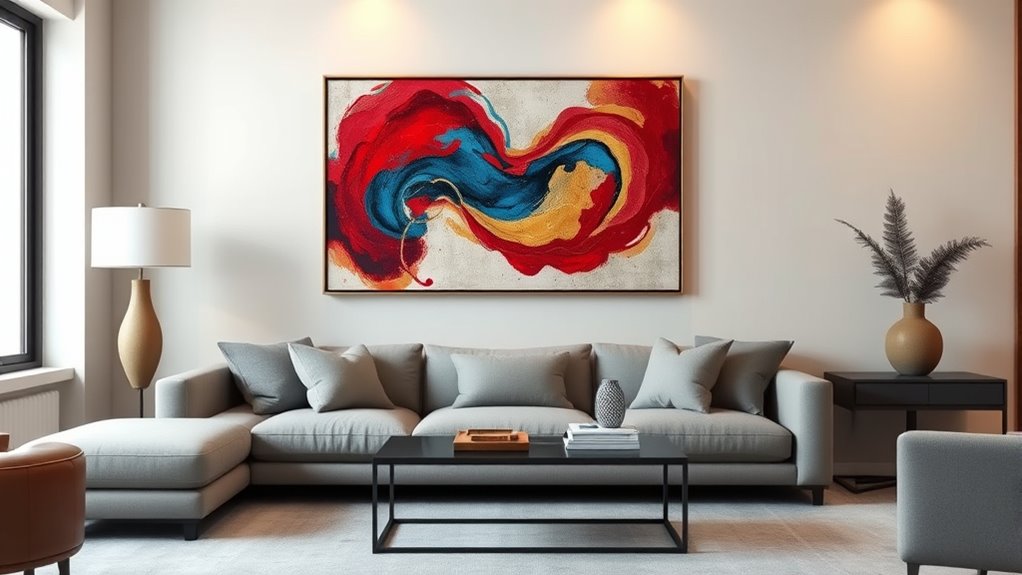
Hanging and positioning art correctly can transform a room, but it requires careful attention to detail. Start by selecting the right height: generally, the center of the artwork should be at eye level, about 57-60 inches from the floor. Use a measuring tape and a level to ensure precise placement. For larger pieces, hang them so that their midpoint aligns with your eye level; for smaller works, you can position them slightly higher. Leave enough space around the artwork to prevent clutter and create visual balance. When hanging multiple pieces, arrange them in a cohesive grouping with consistent spacing. Always use appropriate hardware for the weight of your art, and double-check that everything is secure before stepping back to admire your work.
Frequently Asked Questions
How Can I Protect My Artwork From Sunlight and Environmental Damage?
You want to protect your artwork from sunlight and environmental damage. To do this, avoid placing pieces in direct sunlight, as UV rays can fade colors. Use UV-protective glass or acrylic when framing, and keep your art away from heat, humidity, and pollution sources. Regularly inspect your artwork for signs of damage, and consider using climate control or dehumidifiers to maintain a stable environment.
What Are Budget-Friendly Options for High-Quality Artwork?
Oh, because splurging on gallery-quality art is obviously what everyone dreams of, right? But if you’re on a budget, don’t worry—there are plenty of ways to score high-quality artwork without breaking the bank. You can explore local art fairs, buy prints from emerging artists, or visit thrift stores for vintage masterpieces. Plus, online marketplaces like Etsy offer affordable, unique pieces that elevate your space without draining your wallet.
How Do I Incorporate Art Into Non-Traditional or Small Spaces?
In small or unconventional spaces, you can make art stand out by choosing smaller pieces or creating a gallery wall with various framed images. Use mirrors or reflective surfaces to add depth and brightness. Hang art at eye level for impact, and consider leaning larger pieces against walls for a relaxed vibe. Play with unconventional placements, like above doorways or in corners, to add personality without overwhelming the space.
Can I Mix Different Art Styles in a Single Room Effectively?
Mixing different art styles in a room works if you create balance and harmony. You can achieve this by using a unifying element, like a common color palette or similar framing. Start with one statement piece, then add complementary artworks that contrast or echo it. Trust your instincts, and don’t be afraid to experiment—variety can add personality and depth to your space if you keep it cohesive.
What Lighting Techniques Enhance the Display of Artwork at Home?
Who knew lighting could be the secret to elevating your art display? You should aim for adjustable, focused lighting like track or picture lights to highlight details. Avoid harsh fluorescent bulbs and opt for warm LED options instead. Play with angles to create depth and shadows, making each piece pop. Remember, good lighting doesn’t just show off your art—it transforms your entire space into a gallery.
Conclusion
By thoughtfully selecting and placing artwork, you transform your home into a personal gallery that reflects your soul. Remember, your space isn’t just a backdrop—it’s a canvas for your unique story. So, why settle for ordinary walls when you can turn them into extraordinary expressions of you? Embrace your style, trust your instincts, and let your art speak volumes. After all, isn’t your home the perfect masterpiece waiting to be revealed?
